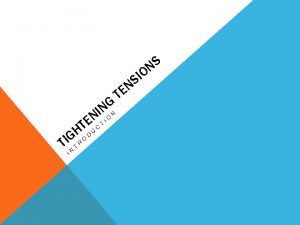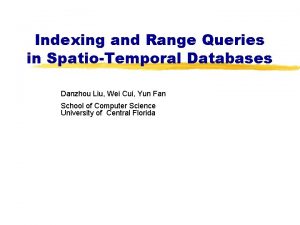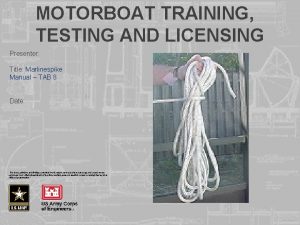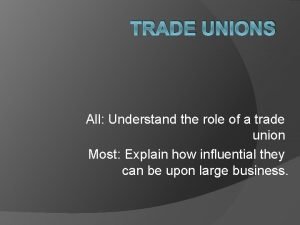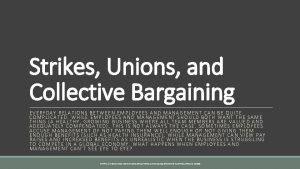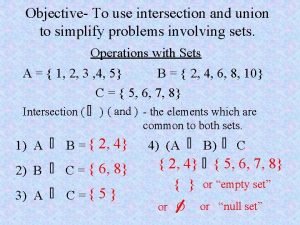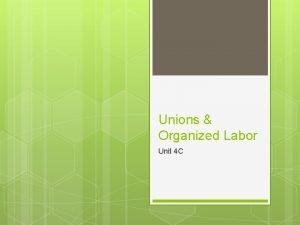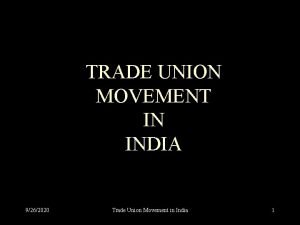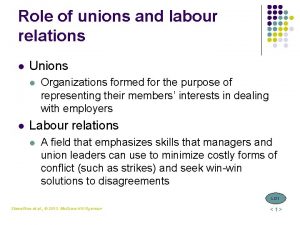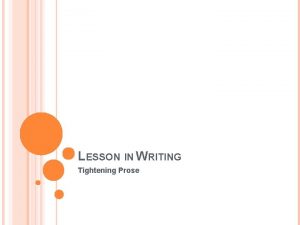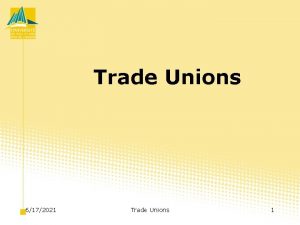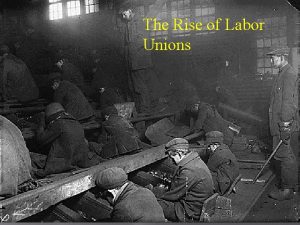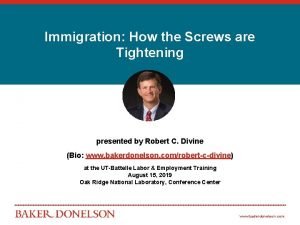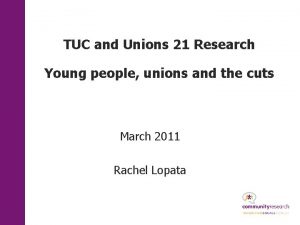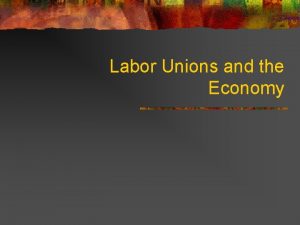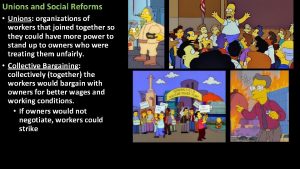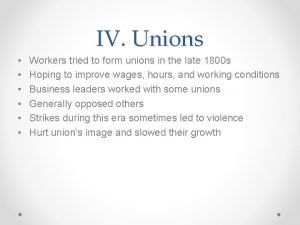Unions and a Tightening on Immigration The Rise

















- Slides: 17

+ Unions and a Tightening on Immigration

+ The Rise of Unions n Canada was prosperous, but the prosperity of the time was something that was not shared around equally. n. A few major corporate giants controlled a majority of the industry and finance of the country. n i. e. Imperial Oil, and Dunsmuir Coal. n Few people in the population were able to see any of the money in these companies, and their wealth sharply contrasted that of the poor working class people.

A Need for Reform n Many flaunted their wealth and built huge mansions and homes for themselves. n i. e. Dunsmuir Craigdarroch Castle in Victoria. n The gap between the poor working class and the wealth grew bigger, and workers began to look for their share in the wealth they generated for the owners of the businesses.

+ The Rise of Unions

+ Violence and Discontent n Labor n unions began to arise between 1880 -1910. Approx. 10% of all workers joined a union during this time. n The problems the unions faced were that the employers could easily replace the workers, and the government and legal system tended to favor the rich owners opposed to the workers. n Companies had private police to deal with any disturbances that may have arisen from public protest or people wanting to go on strike. n Between 1910 and WWI, there were a number of different violent confrontations that erupted between employers and workers. n Coal miners in Nanaimo who worked for the Dunsmuir family were involved in a 2 year strike over unsafe working conditions and low pay. n Pg. 270 of your text.

+ Closing the Door to Immigration n Not everyone was a fan of the immigration that was happening as a result of the Sifton open-door policy. n Labour organizations saw it as a threat, British Canadians feared that it would alter the British character of the country, and the French feared that they would become more of a minority and their culture and language would be lost. n Businesses liked the idea of the immigration because it provided a cheap labour pool for them to hire people out of n Immigration was especially an issue in BC were many felt that their jobs were threatened by the large numbers of Asian immigrants. n BC pressured the federal government to do something as a result.

Frank Oliver: Minister of the Interior n 1905, Frank Oliver replace Sifton as Minister of the Interior. n Oliver agreed with reducing the number of immigrants, and he introduced a more selective immigration policy. n He especially agreed with limiting the number of non-white immigrants. n Provincial governments began to restrict Chinese, Japanese, and East Indian immigration.

+ British Columbia: The“Golden Mountain” n The construction of the CPR and the Cariboo Gold Rush brought large amounts of Chinese immigrants to BC. n They comprised the largest group of Asian n 1891, 9400 Chinese were living in BC. n Many immigrants. had planned to return back to China. n. A majority lived in “Chinatowns”, which become places of business and cultural organizations. n. A majority of the Chinese workers were employed in the salmon canning and coal mining industries on Vancouver Island. n Many companies wanted to hire the Chinese because they would work hard for low wages.

British Columbia: The “Golden Mountain” n Victoria's ramshackle Chinatown 1886

Unions Contribute to Discrimination + n It was the labour organizations that become key in getting exclusionary legislation against the Chinese because they felt their jobs were being threatened as a result of the Chinese undercutting them. n Groups were formed to put up protest against the Asian immigration. n i. e. Asiatic Exclusion League. n Things come to a head in 1907 when Lt. Governor James Dunsmuir refused to sign a bill to exclude Japanese immigrants from entering Canada.

+ Riot n The actions of Dunsmuir had protesters march on Vancouvers city hall, and a riot ensued. n Roughly 1000 demonstrators marched through the streets of Chinatown and Japanese sections of the city damaging businesses, etc. n The riot focused international attention on Vancouver. n PM Laurier was embarrassed, and as a result of Japanese being a British ally, Laurier apologized and created a Royal Commission to look at the matter. n The Government still went about setting a 400 person limit on the number of Japanese that were allowed in Canada per year.


+ By “Continuous Passage” Only n William Lyon Mackenzie King, Laurier’s Minister of Labour, was in charge of the Royal Commission that looked at the Vancouver Riots. n He was too also look at the immigration of people from Asia as a whole, and look at how they had been enticed to come to Canada to work. n Since 1904, CPR agents had been encouraging Sikhs to immigrate. n It was difficult to restrict them access because they were British subjects and could not be denied access to Canada.

+ Komagata Maru n To prevent any more East Indians from immigrating, the Immigration Act of 1906 is introduced. n Immigration rules were now changed to make sure the immigrants now had to come from their country of origin on a non-stop direct route. n A direct route from India was impossible, and the government believed that they had solved the immigration issue. n The amendment was challenged in 1914 when the Komagata Maru, a steamer chartered by Gurdit Singh, arrived in Vancouver with 354 Sikh immigrants.

+ Komagata Maru Continued… n Komagata Maru arrived in Vancouver on May 23 after stops in China and Japan, and was immediately quarantined by Canadian authorities. n Passengers were not allowed to leave the ship. n Supporters argued that the continuous-passage rule was invalid, but the government would not budge. n Officials and police officers tried boarding the ship, but they were bombed with sticks and bottles to keep them away. n July 23 the ship was escorted out of the Vancouver Harbour by the cruiser Rainbow, one of the Naval ships Britain had loaned Canada.

+ By “Continuous Passage” Only

+ By “Continuous Passage” Only
 Tricky dicky richard nixon
Tricky dicky richard nixon Rise and rise until lambs become lions
Rise and rise until lambs become lions Rise again and again until lambs
Rise again and again until lambs Rise and rise again until lambs become lions origin
Rise and rise again until lambs become lions origin Tightening tension pebble, rock, boulder
Tightening tension pebble, rock, boulder Tightening
Tightening Used for quick, temporarypost, spar or stake.
Used for quick, temporarypost, spar or stake. Spanish donkey-medieval torture
Spanish donkey-medieval torture Pros and cons of trade unions
Pros and cons of trade unions The role of trade unions in the economy of a country
The role of trade unions in the economy of a country Strikes unions and collective bargaining
Strikes unions and collective bargaining Simplify union and intersection
Simplify union and intersection Credit union vs building society
Credit union vs building society What is organized labor
What is organized labor Western kenya union conference of sda
Western kenya union conference of sda Benefits of trade unions
Benefits of trade unions Types of unions
Types of unions Inherent risks examples
Inherent risks examples




